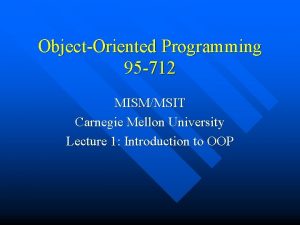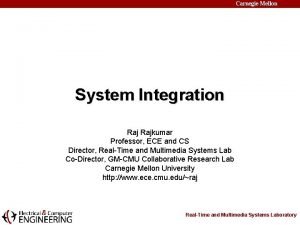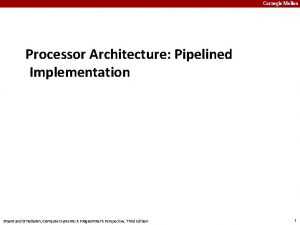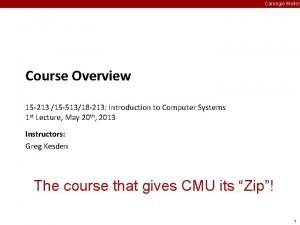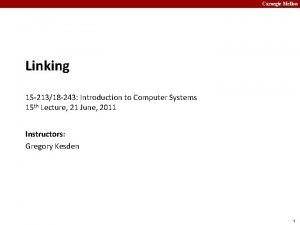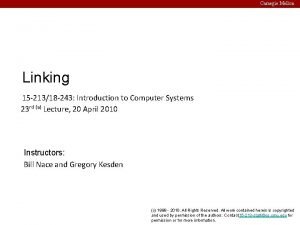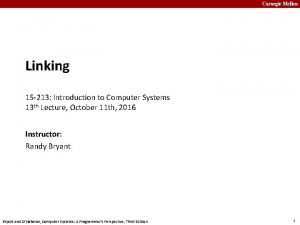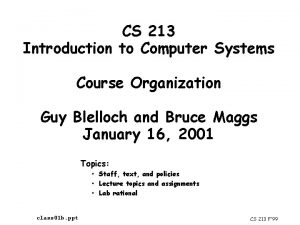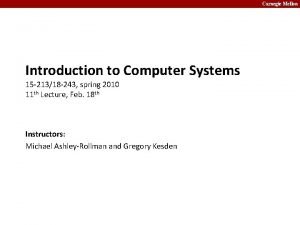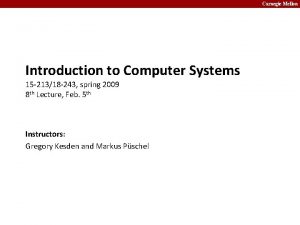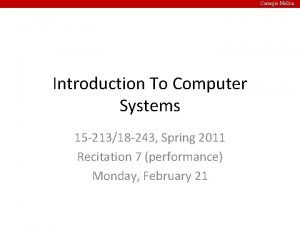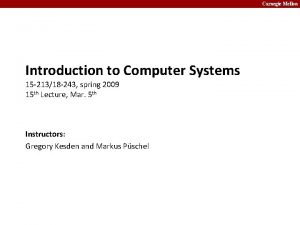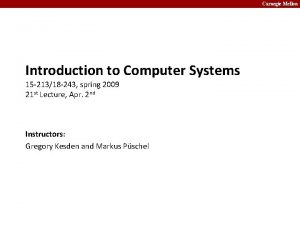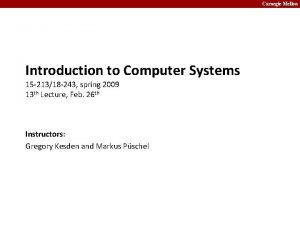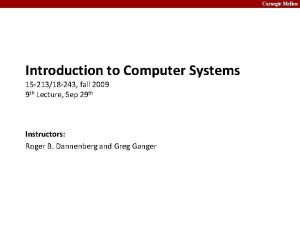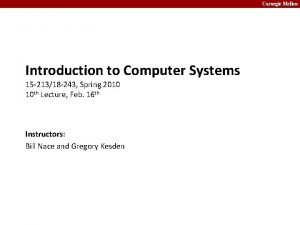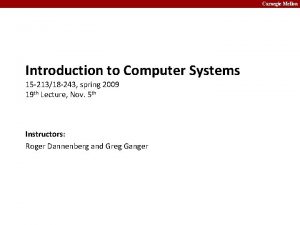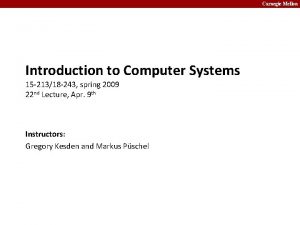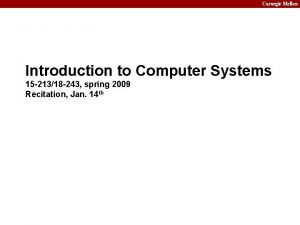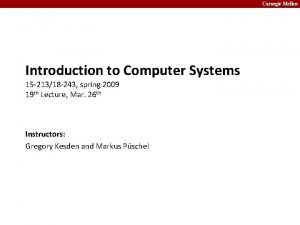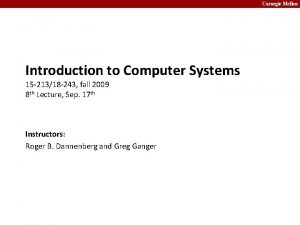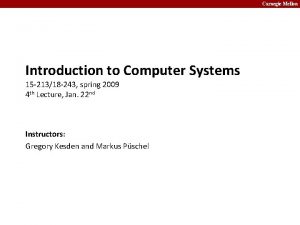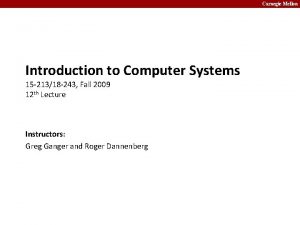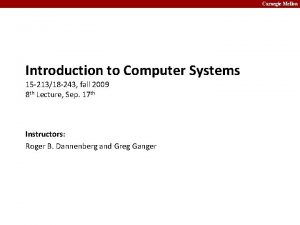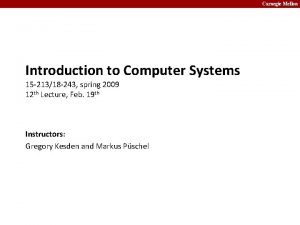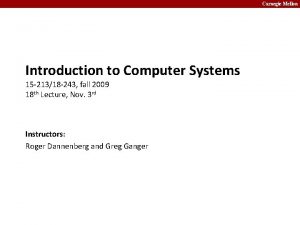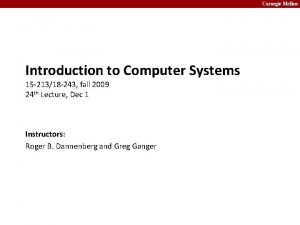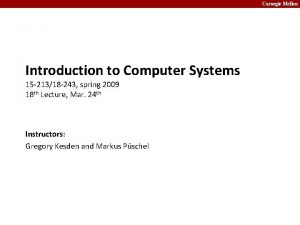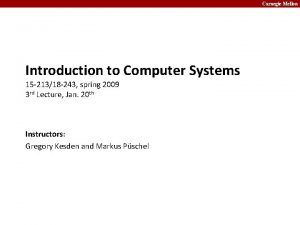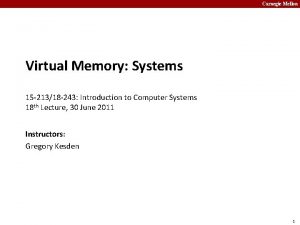Carnegie Mellon Introduction to Computer Systems 15 21318
































![Carnegie Mellon Implicit List: Bidirectional Coalescing ¢ Boundary tags [Knuth 73] § Replicate size/allocated Carnegie Mellon Implicit List: Bidirectional Coalescing ¢ Boundary tags [Knuth 73] § Replicate size/allocated](https://slidetodoc.com/presentation_image_h2/5c54fc440899206b6d470528883038f5/image-33.jpg)








- Slides: 41

Carnegie Mellon Introduction to Computer Systems 15 -213/18 -243, spring 2010 18 th Lecture, Mar. 25 th Instructors: Bill Nace and Gregory Kesden

Carnegie Mellon Last Time: Linux VM as Collection of “Areas” task_struct mm vm_area_struct mm_struct pgd mmap vm_end vm_start vm_prot vm_flags vm_next ¢ ¢ § Page directory address vm_end vm_start vm_prot vm_flags vm_prot: vm_next pgd: § Read/write permissions for this area ¢ vm_flags § Shared with other processes or private to this process virtual memory shared libraries 0 x 40000000 data 0 x 0804 a 020 text vm_end vm_start vm_prot vm_flags vm_next 0 x 08048000 0

Carnegie Mellon Last Time: Memory Mapping ¢ Creation of new VM area § Create new vm_area_struct and page tables for area ¢ Area can be backed by (i. e. , get its initial values from) : § File on disk copy-on-write possible (e. g. , fork()) § Nothing (e. g. , . bss) § demand-zero § ¢ Key point: no virtual pages are copied into physical memory until they are referenced! § Known as “demand paging”

Carnegie Mellon Last Time: P 6 Address Translation 32 result CPU 20 VPN 12 VPO 16 TLBT virtual address (VA) . . . TLB hit L 1 (128 sets, 4 lines/set) . . . TLB (16 sets, 4 entries/set) 10 10 VPN 1 VPN 2 20 PPN PDE PDBR L 1 miss L 1 hit 4 TLBI TLB miss L 2 and DRAM Page tables PTE 12 PPO physical address (PA) 20 CT 7 5 CI CO

Carnegie Mellon Today ¢ ¢ Performance optimization for VM system Dynamic memory allocation

Carnegie Mellon Large Pages ¢ ¢ ¢ 10 12 20 12 VPN VPO 20 12 PPN PPO 10 12 PPN PPO versus 4 MB on 32 -bit, 2 MB on 64 -bit Simplify address translation Useful for programs with very large, contiguous working sets § Reduces compulsory TLB misses ¢ How to use (Linux) § hugetlbfs support (since at least 2. 6. 16) § Use libhugetlbs § {m, c, re}alloc replacements

Carnegie Mellon Buffering: Example MMM ¢ Blocked for cache c ¢ =i 1 Block size B x B a b * Assume blocking for L 2 cache § say, 512 MB = 219 B = 216 doubles = C § 3 B 2 < C means B ≈ 150 + c

Carnegie Mellon Buffering: Example MMM (cont. ) ¢ But: Look at one iteration c = assume > 4 KB = 512 doubles a b * + c blocksize B = 150 each row used O(B) times but every time O(B 2) ops between ¢ Consequence § Each row is on different page § More rows than TLB entries: TLB thrashing § Solution: buffering = copy block to contiguous memory § O(B 2) cost for O(B 3) operations

Carnegie Mellon Today ¢ ¢ Performance optimization for VM system Dynamic memory allocation

Carnegie Mellon Process Memory Image kernel virtual memory protected from user code stack %esp Allocators request additional heap memory from the kernel using the sbrk() function: the “brk” ptr run-time heap (via malloc) error = sbrk(amt_more) uninitialized data (. bss) initialized data (. data) program text (. text) 0

Carnegie Mellon Why Dynamic Memory Allocation? ¢ Sizes of needed data structures may only be known at runtime

Carnegie Mellon Dynamic Memory Allocation ¢ ¢ Memory allocator? § VM hardware and kernel allocate pages § Application objects are typically smaller § Allocator manages objects within pages Application Dynamic Memory Allocator Heap Memory Explicit vs. Implicit Memory Allocator § Explicit: application allocates and frees space § In C: malloc() and free() § Implicit: application allocates, but does not free space § ¢ Allocation § A memory allocator doles out memory blocks to application § A “block” is a contiguous range of bytes § ¢ In Java, ML, Lisp: garbage collection of any size, in this context Today: simple explicit memory allocation

Carnegie Mellon Malloc Package ¢ #include <stdlib. h> ¢ void *malloc(size_t size) § Successful: § Returns a pointer to a memory block of at least size bytes (typically) aligned to 8 -byte boundary § If size == 0, returns NULL § Unsuccessful: returns NULL (0) and sets errno ¢ void free(void *p) § Returns the block pointed at by p to pool of available memory § p must come from a previous call to malloc() or realloc() ¢ void *realloc(void *p, size_t size) § Changes size of block p and returns pointer to new block § Contents of new block unchanged up to min of old and new size § Old block has been free()'d (logically, if new != old)

Carnegie Mellon Malloc Example void foo(int n, int m) { int i, *p; /* allocate a block of n ints */ p = (int *)malloc(n * sizeof(int)); if (p == NULL) { perror("malloc"); exit(0); } for (i=0; i<n; i++) p[i] = i; /* add m bytes to end of p block */ if ((p = (int *)realloc(p, (n+m) * sizeof(int))) == NULL) { perror("realloc"); exit(0); } for (i=n; i < n+m; i++) p[i] = i; /* print new array */ for (i=0; i<n+m; i++) printf("%dn", p[i]); } free(p); /* return p to available memory pool */

Carnegie Mellon Assumptions Made in This Lecture ¢ Memory is word addressed (each word can hold a pointer) Allocated block (4 words) Free block (3 words) Free word Allocated word

Carnegie Mellon Allocation Example p 1 = malloc(4) p 2 = malloc(5) p 3 = malloc(6) free(p 2) p 4 = malloc(2)

Carnegie Mellon Constraints ¢ Applications § Can issue arbitrary sequence of malloc() and free() requests § free() requests must be to a malloc()’d block ¢ Allocators § Can’t control number or size of allocated blocks § Must respond immediately to malloc() requests i. e. , can’t reorder or buffer requests Must allocate blocks from free memory § i. e. , can only place allocated blocks in free memory Must align blocks so they satisfy all alignment requirements § 8 byte alignment for GNU malloc (libc malloc) on Linux boxes Can manipulate and modify only free memory Can’t move the allocated blocks once they are malloc()’d § i. e. , compaction is not allowed § § §

Carnegie Mellon Performance Goal: Throughput ¢ Given some sequence of malloc and free requests: § R 0, R 1, . . . , Rk, . . . , Rn-1 ¢ Goals: maximize throughput and peak memory utilization § These goals are often conflicting ¢ Throughput: § Number of completed requests per unit time § Example: 5, 000 malloc() calls and 5, 000 free() calls in 10 seconds § Throughput is 1, 000 operations/second § How to do malloc() and free() in O(1)? What’s the problem? §

Carnegie Mellon Performance Goal: Peak Memory Utilization ¢ Given some sequence of malloc and free requests: § R 0, R 1, . . . , Rk, . . . , Rn-1 ¢ Def: Aggregate payload Pk § malloc(p) results in a block with a payload of p bytes § After request Rk has completed, the aggregate payload Pk is the sum of currently allocated payloads § all malloc()’d stuff minus all free()’d stuff ¢ Def: Current heap size = Hk § Assume Hk is monotonically nondecreasing § ¢ reminder: it grows when allocator uses sbrk() Def: Peak memory utilization after k requests § Uk = ( maxi<k Pi ) / Hk

Carnegie Mellon Fragmentation ¢ Poor memory utilization caused by fragmentation § internal fragmentation § external fragmentation

Carnegie Mellon Internal Fragmentation ¢ For a given block, internal fragmentation occurs if payload is smaller than block size block Internal fragmentation ¢ payload Caused by § overhead of maintaining heap data structures § padding for alignment purposes § explicit policy decisions (e. g. , to return a big block to satisfy a small request) ¢ Depends only on the pattern of previous requests § thus, easy to measure Internal fragmentation

Carnegie Mellon External Fragmentation ¢ Occurs when there is enough aggregate heap memory, but no single free block is large enough p 1 = malloc(4) p 2 = malloc(5) p 3 = malloc(6) free(p 2) p 4 = malloc(6) ¢ Oops! (what would happen now? ) Depends on the pattern of future requests § Thus, difficult to measure

Carnegie Mellon Implementation Issues ¢ ¢ ¢ How to know how much memory is being free()’d when it is given only a pointer (and no length)? How to keep track of the free blocks? What to do with extra space when allocating a block that is smaller than the free block it is placed in? ¢ How to pick a block to use for allocation—many might fit? ¢ How to reinsert a freed block into the heap?

Carnegie Mellon Knowing How Much to Free ¢ Standard method § Keep the length of a block in the word preceding the block. This word is often called the header field or header § Requires an extra word for every allocated block § p 0 = malloc(4) 5 block size free(p 0) data

Carnegie Mellon Keeping Track of Free Blocks ¢ Method 1: Implicit list using length—links all blocks 5 ¢ 6 2 Method 2: Explicit list among the free blocks using pointers 5 ¢ 4 4 6 2 Method 3: Segregated free list § Different free lists for different size classes ¢ Method 4: Blocks sorted by size § Can use a balanced tree (e. g. Red-Black tree) with pointers within each free block, and the length used as a key

Carnegie Mellon Implicit List ¢ For each block we need: length, is-allocated? § Could store this information in two words: wasteful! ¢ Standard trick § If blocks are aligned, some low-order address bits are always 0 § Instead of storing an always-0 bit, use it as a allocated/free flag § When reading size word, must mask out this bit 1 word size Format of allocated and free blocks payload a a = 1: allocated block a = 0: free block size: block size payload: application data (allocated blocks only) optional padding

Carnegie Mellon Example (Blackboard? ) Sequence of blocks in heap: 2/0, 4/1, 8/0, 4/1 Start of heap Free word 2/0 4/1 8/0 4/1 0/1 Allocated word unused 8 bytes = 2 word alignment ¢ 8 -byte alignment § May require initial unused word § Causes some internal fragmentation ¢ ¢ One word (0/1) to mark end of list Here: block size in words for simplicity

Carnegie Mellon Implicit List: Finding a Free Block ¢ First fit: § Search list from beginning, choose first free block that fits: (Cost? ) p = start; while ((p < end) && ((*p & 1) || (*p <= len))) p = p + (*p & -2); \ \ not passed end already allocated too small goto next block (word addressed) § Can take linear time in total number of blocks (allocated and free) § In practice it can cause “splinters” at beginning of list ¢ ¢ Next fit: § Like first-fit, but search list starting where previous search finished § Should often be faster than first-fit: avoids re-scanning unhelpful blocks § Some research suggests that fragmentation is worse Best fit: § Search the list, choose the best free block: fits, with fewest bytes left over § Keeps fragments small—usually helps fragmentation § Will typically run slower than first-fit

Carnegie Mellon Implicit List: Allocating in Free Block ¢ Allocating in a free block: splitting § Since allocated space might be smaller than free space, we might want to split the block 4 4 6 2 p addblock(p, 4) 4 4 4 void addblock(ptr p, int len) { int newsize = ((len + 1) >> 1) << 1; int oldsize = *p & -2; *p = newsize | 1; if (newsize < oldsize) *(p+newsize) = oldsize - newsize; } 2 2 // round up to even // mask out low bit Blackboard? // set new length (will disappear) // set length in remaining // part of block

Carnegie Mellon Implicit List: Allocating in Free Block ¢ Allocating in a free block: splitting § Since allocated space might be smaller than free space, we might want to split the block 4 4 6 2 p addblock(p, 4) 4 4 4 void addblock(ptr p, int len) { int newsize = ((len + 1) >> 1) << 1; int oldsize = *p & -2; *p = newsize | 1; if (newsize < oldsize) *(p+newsize) = oldsize - newsize; } 2 2 // round up to even // mask out low bit // set new length // set length in remaining // part of block

Carnegie Mellon Implicit List: Freeing a Block ¢ Simplest implementation: § Need only clear the “allocated” flag void free_block(ptr p) { *p = *p & -2 } § But can lead to “false fragmentation” 4 4 2 2 p free(p) 4 malloc(5) 4 4 4 Oops! There is enough free space, but the allocator won’t be able to find it

Carnegie Mellon Implicit List: Coalescing ¢ Join (coalesce) with next/previous blocks, if they are free § Coalescing with next block 4 4 4 2 2 p free(p) 4 4 void free_block(ptr p) { *p = *p & -2; next = p + *p; if ((*next & 1) == 0) *p = *p + *next; } 6 // clear allocated flag // find next block // add to this block if // not allocated § But how do we coalesce with previous block? logically gone
![Carnegie Mellon Implicit List Bidirectional Coalescing Boundary tags Knuth 73 Replicate sizeallocated Carnegie Mellon Implicit List: Bidirectional Coalescing ¢ Boundary tags [Knuth 73] § Replicate size/allocated](https://slidetodoc.com/presentation_image_h2/5c54fc440899206b6d470528883038f5/image-33.jpg)
Carnegie Mellon Implicit List: Bidirectional Coalescing ¢ Boundary tags [Knuth 73] § Replicate size/allocated word at “bottom” (end) of free blocks § Allows us to traverse the “list” backwards, but requires extra space § Important and general technique! 4 4 4 Header Format of allocated and free blocks Boundary tag (footer) 4 6 size 6 4 a payload and padding size 4 a = 1: allocated block a = 0: free block size: total block size a payload: application data (allocated blocks only)

Carnegie Mellon Constant Time Coalescing block being freed Case 1 Case 2 Case 3 Case 4 allocated free

Carnegie Mellon Constant Time Coalescing (Case 1) m 1 1 m 1 n 1 0 n m 2 1 1 n m 2 0 1 m 2 1

Carnegie Mellon Constant Time Coalescing (Case 2) m 1 1 m 1 n+m 2 1 0 n m 2 1 0 m 2 0 n+m 2 0

Carnegie Mellon Constant Time Coalescing (Case 3) m 1 0 n+m 1 0 m 1 n 0 1 n m 2 1 1 n+m 1 m 2 0 1 m 2 1

Carnegie Mellon Constant Time Coalescing (Case 4) m 1 0 m 1 n 0 1 n m 2 1 0 m 2 0 n+m 1+m 2 0

Carnegie Mellon Disadvantages of Boundary Tags ¢ Internal fragmentation ¢ Can it be optimized? § Which blocks need the footer tag? § What does that mean?

Carnegie Mellon Summary of Key Allocator Policies ¢ Placement policy: § First-fit, next-fit, best-fit, etc. § Trades off lower throughput for less fragmentation § Interesting observation: segregated free lists (next lecture) approximate a best fit placement policy without having to search entire free list ¢ Splitting policy: § When do we go ahead and split free blocks? § How much internal fragmentation are we willing to tolerate? ¢ Coalescing policy: § Immediate coalescing: coalesce each time free() is called § Deferred coalescing: try to improve performance of free() by deferring coalescing until needed. Examples: § Coalesce as you scan the free list for malloc() § Coalesce when the amount of external fragmentation reaches some threshold

Carnegie Mellon Implicit Lists: Summary ¢ ¢ Implementation: very simple Allocate cost: § linear time worst case ¢ Free cost: § constant time worst case § even with coalescing ¢ Memory usage: § will depend on placement policy § First-fit, next-fit or best-fit ¢ Not used in practice for malloc()/free() because of linear-time allocation § used in many special purpose applications ¢ However, the concepts of splitting and boundary tag coalescing are general to allocators
 Cmu comp bio
Cmu comp bio Carnegie mellon interdisciplinary
Carnegie mellon interdisciplinary Carnegie mellon software architecture
Carnegie mellon software architecture Bomb threat carnegie mellon
Bomb threat carnegie mellon Carnegie mellon software architecture
Carnegie mellon software architecture Carnegie mellon university research participants
Carnegie mellon university research participants Mism carnegie mellon
Mism carnegie mellon Randy pausch time management slides
Randy pausch time management slides Kevin thompson nsf
Kevin thompson nsf Iit
Iit Carnegie mellon
Carnegie mellon Cmu vpn
Cmu vpn Carnegie mellon
Carnegie mellon Carnegie mellon
Carnegie mellon Carnegie mellon
Carnegie mellon Frax
Frax Carnegie mellon fat letter
Carnegie mellon fat letter Carnegie mellon
Carnegie mellon Cmu bomb lab
Cmu bomb lab Mellon serbia iskustva
Mellon serbia iskustva Carneigh mellon
Carneigh mellon Conclusion of breastfeeding
Conclusion of breastfeeding Wageworks health equity
Wageworks health equity Mellon tubes
Mellon tubes Water mellon
Water mellon Mellon elf
Mellon elf Mellon elf
Mellon elf Mellon elf
Mellon elf Cit 593
Cit 593 15-213 introduction to computer systems
15-213 introduction to computer systems 15-213 introduction to computer systems
15-213 introduction to computer systems Carnegie hero
Carnegie hero The rise
The rise Was andrew carnegie bad
Was andrew carnegie bad Modelo de carnegie
Modelo de carnegie Andrew carnegie vertical integration
Andrew carnegie vertical integration Andrew carnegie vertical integration
Andrew carnegie vertical integration Andrew carnegie vertical integration
Andrew carnegie vertical integration Horizontal integration rockefeller
Horizontal integration rockefeller Andrew carnegie and john d. rockefeller venn diagram
Andrew carnegie and john d. rockefeller venn diagram Dale carnegie conversation stack
Dale carnegie conversation stack Carnegie learning
Carnegie learning






